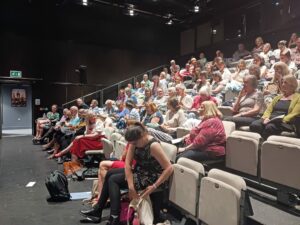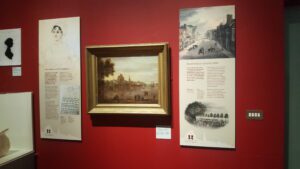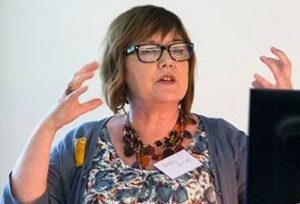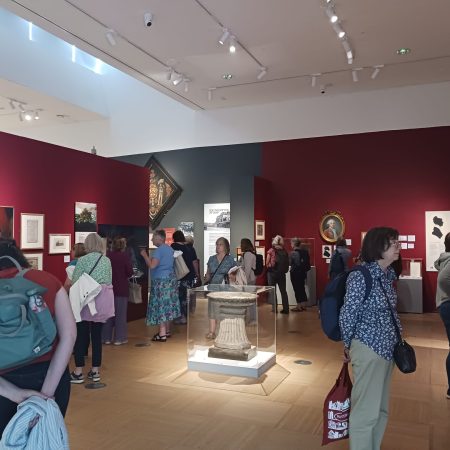As part of the programme of events marking the 250th Anniversary of Jane Austen’s birth, the author’s former home of Southampton hosted a sellout study day ‘Placing Jane’. This event invited attendees to look beyond Austen’s works and consider how a national literary figure is deeply connected to local contexts. It aimed to highlight the value of local historians drawing from other disciplines to unlock new approaches to thinking and research to broaden perspectives by introducing fresh ideas and insights. The day’s success was shaped by the exceptional calibre of each speaker who were knowledgeable, engaging and entertaining. The programme had three distinct sub themes – Literary Landscapes, Jane Austen Dramatized, and Letters, Journals, Household Books & Diaries.

Literary Landscapes
Gillian Dow further examined the role of place in Jane Austen’s fiction, also reversing the perspective to consider how Austen’s works contribute to place by sustaining the literary and heritage tourism industry. While certain locations have been linked as possible inspirations within Austen’s writing, her novels do not offer detailed descriptions of places. However, through her characters’ viewpoints, we gain valuable insights into contemporary attitudes toward place and domestic spaces.
Nicola Pritchard-Pink concluded the session by examining Jane Austen’s experience of walking, as reflected in her letters and novels, alongside insights from contemporary conduct books and sketches. She explored questions such as how far Austen walked, where and when she ventured out, and her reasons for doing so. Nicola’s discussion shed light on contemporary attitudes and social expectations surrounding walking during Austen’s time.

Jane Austen Dramatized
Jo Willett delivered a compelling account of the life and career of Sarah Siddons (1755–1831), widely regarded as Jane Austen’s favourite actor—though whether they ever met remains uncertain. Celebrated as the finest tragic actress of her time, Sarah reached the pinnacle of her career as the highest-earning performer on the London stage. Jo explored the hardships of Sarah’s early years, the gruelling realities of touring theatre companies, and the prevailing prejudices against actors, especially women in the profession.
Next, and to much delight, Angela Barlow captivated the room with a mesmerising performance, bringing Austen’s characters to life through their own words. She explored how Austen shapes her characters through their interactions, internal reflections, and actions.
Letters, Journals, Household Books & Diaries
Holly Day presented her research on Ladies Pocket Books, also known as Memorandum Books—annual publications designed to help women organise their daily lives. These books combined printed content with space for personal entries, offering insights into social engagements, business appointments, and financial expenditures. Holly traced their evolution as a consumer product, explored how women utilised them, and uncovered a fascinating connection to Jane Austen.
In the day’s final presentation, John McAleer offered a compelling account of the travels of William Henry Ridding (1786–1810), a cadet in the East India Military Service. Setting sail from Southampton aboard The Union, William embarked on a journey to Madras in pursuit of fortune and recognition. Tragically, he never returned, succumbing to illness in Madras. Through letters to his mother, Elizabeth—including journal entries written onboard ship—William’s observations and experiences shed valuable light on the broader world that shaped Jane Austen’s era.

As the organiser of the event, it was down to me to introduce the local context for each theme, Austen’s links with Southampton and the impact on her writing, her experience of theatre in Southampton and its connection with Sarah Siddons and a review of the archive material which provided the content for the exhibition ‘A Very Respectable Company’ running at Sea City until the end of the year. It was also a joy to be a member of the audience every presentation was thought provoking and bought a new slant on the world in which Austen lived. Gillian Dow’s presentation really highlighted how the ‘Austen Industry’ has skewed the image of the sphere in which Austen actually lived and about which she wrote, that it was not about the huge palatial mansions, most of her characters lived in what contemporaries would call villas or Georgian vicarages. This was further highlighted by Nicola Pritchard-Pink with her detailed examination about the importance of walking and the countryside. The 18th century was when the importance of walking to health was being stressed. How liberating it must have been for women to be out of the panniers and powdered wigs and to be able to move and climb over styles. Jo Willett’s observations about Mrs Siddons style and performance illustrated the difference between that and Jane’s approach to writing and yet Austen so admired her. Siddons was another woman who had to find a way to make a mark in the world and support her family. It was fabulous to have Angela Barlow give the actors perspective on Austen’s characterisations. The illustrations of Austen’s wonderful dialogue must have been linked to her love of theatre and those amateur performances as well as the professional stagings she had seen, and Austen’s views on the short-comings of the Southampton theatre must have been formed around her knowledge of theatre and performance. Angela’s presentation also showed how Austen’s work so easily transitioned into stage plays, TV and Film and all her adapters acknowledge they don’t need to change her dialogue. The world of the pocket diaries was unveiled by Holly Day who showed how they were used as a receptacle for secrets, with personal notes and comments from their owners. It was astounding how many were produced and over such a long period. There was also the discovery that a set of surviving personal accounts of Jane Austen where actually pages from a pocket book. Those accounts – so well known and yet not known at all. Why did those pages survive? where are the rest? was Cassandra at work again or were the pocket books so disposable, you used them but at the end of the year you cut out the pictures, the dance moves, the enigmas and disposed of the rest. Did Jane Austen send in enigmas to be published, what was on the back of those accounts that made them worth keeping? The day finished with the story of poor, inept William Henry Ridding, whose fleeting life was brought vividly to life by John McAleer. The poor boy was so hopeless that even with all his father’s contacts he could only just grasp that very lowest rung of the East India Company ladder. He sailed away to India as the Austens moved into Southampton, the families were known to one another and perhaps Mrs Austen and Mrs Ridding sat with the letters their sons sent from far off spaces and exchanged its of news and gossip. All the papers helped people to look at Austen’s life, circle, experiences, in a new way so much food for thought.

Author: Dr Cheryl Butler
Bio: Dr Cheryl Butler is a Fellow of the Royal Historical Society, Fellow of the Royal Society of Arts, and Honorary Fellow of the University of Winchester and is a member of the editorial board for the Southampton Records Series and the Hampshire Papers. She has published a number of books and papers which have drawn upon the archives from the Southampton Records office and Hampshire Archives including three Southampton Records Series volumes on the Southampton Mayors Book of Fines; the oral history of Itchen Ferry Village We only wore shoes on Sunday; a book on Tudor Southampton: Rioters, Revellers & Reformers; Jane Austen & Southampton Spa and Powder, Prisoners & Paintings – The Story of God’s House Tower. She has organised several large award winning community heritage projects including The Diaper Heritage Project; Los Ninos, the story of the Basque Children Refugees; Tudor Revels; The Stinking Fish of Southampton, Jane Austen 200. She is passionate about using archives to inform creative projects and is writer director of the site specific Sarah Siddons Fan Club Theatre Company. She is on the National Training Committee for the British Guild of Tourist Guides and chair of the Diaper Heritage Association one of the largest single name genealogical study organisations. Winner of the British Association of Local History personal achievement award in 2014 and the City of Southampton award in 2018 for services to heritage. She has spoken at numerous national and international conferences raising the profile of Southampton and its rich archives and history. She runs a volunteer palaeography group which transcribes sixteenth century documents and is a published novelist, her novel, The Theatre of the World is set in Elizabethan England, based on original material from Southampton town archives.
Her latest books:
St Mary-over-the-Water; The story of Pear Tree Church 2020
The Remembrance Books of Robert Knaplock 1575 and John Jackson 2021
Telling Other hiStories: early black history in Southampton c1500-1900 2021

